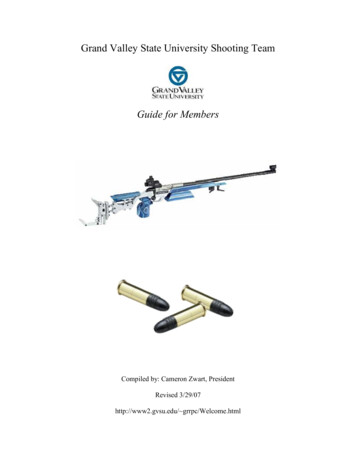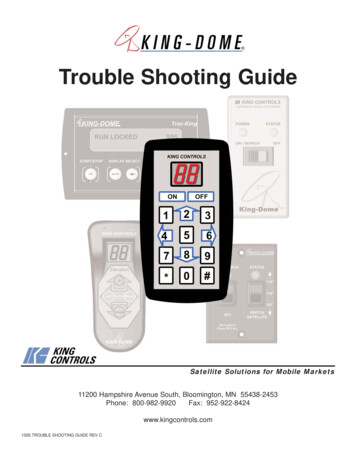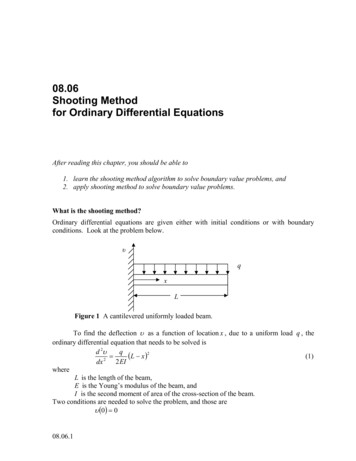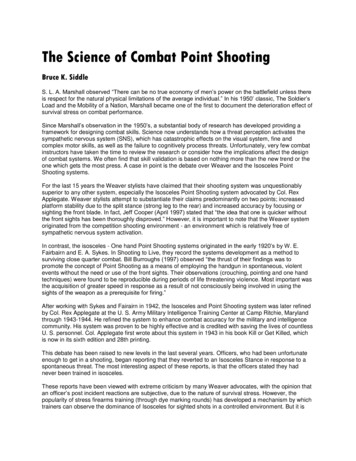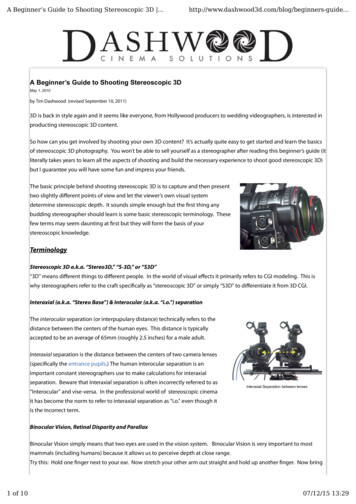
Transcription
A Beginner’s Guide to Shooting Stereoscopic 3D .http://www.dashwood3d.com/blog/beginners-guide.A Beginner’s Guide to Shooting Stereoscopic 3DMay 1, 2010by Tim Dashwood (revised September 10, 2011)3D is back in style again and it seems like everyone, from Hollywood producers to wedding videographers, is interested inproducting stereoscopic 3D content.So how can you get involved by shooting your own 3D content? It’s actually quite easy to get started and learn the basicsof stereoscopic 3D photography. You won’t be able to sell yourself as a stereographer after reading this beginner’s guide (itliterally takes years to learn all the aspects of shooting and build the necessary experience to shoot good stereoscopic 3D)but I guarantee you will have some fun and impress your friends.The basic principle behind shooting stereoscopic 3D is to capture and then presenttwo slightly different points of view and let the viewer’s own visual systemdetermine stereoscopic depth. It sounds simple enough but the first thing anybudding stereographer should learn is some basic stereoscopic terminology. Thesefew terms may seem daunting at first but they will form the basis of yourstereoscopic knowledge.TerminologyStereoscopic 3D a.k.a. “Stereo3D,” “S-3D,” or “S3D”“3D” means different things to different people. In the world of visual effects it primarily refers to CGI modeling. This iswhy stereographers refer to the craft specifically as “stereoscopic 3D” or simply “S3D” to differentiate it from 3D CGI.Interaxial (a.k.a. “Stereo Base”) & Interocular (a.k.a. “i.o.”) separationThe interocular separation (or interpupulary distance) technically refers to thedistance between the centers of the human eyes. This distance is typicallyaccepted to be an average of 65mm (roughly 2.5 inches) for a male adult.Interaxial separation is the distance between the centers of two camera lenses(specifically the entrance pupils.) The human interocular separation is animportant constant stereographers use to make calculations for interaxialseparation. Beware that Interaxial separation is often incorrectly referred to asInteraxial Separation between lenses“Interocular” and vise-versa. In the professional world of stereoscopic cinemait has become the norm to refer to interaxial separation as “i.o.” even though itis the incorrect term.Binocular Vision, Retinal Disparity and ParallaxBinocular Vision simply means that two eyes are used in the vision system. Binocular Vision is very important to mostmammals (including humans) because it allows us to perceive depth at close range.Try this: Hold one finger next to your ear. Now stretch your other arm out straight and hold up another finger. Now bring1 of 1007/12/15 13:29
A Beginner’s Guide to Shooting Stereoscopic 3D ur two fingers together and touch the tips together. Is was easy right? Now repeat the sameprocedure but close one eye. Were you able to touch your fingers together on the first try? Nowyou know how important binocular vision is at close range.When we look around at objects at different distances from us the images of those objects willbe projected on our retinas in slightly different locations for each eye. Our brain can interpretthis “Retinal Disparity” and help us determine depth.When we shoot 3D with two cameras from slightly different positions the same thing happens;each camera’s sensor registers the objects in the scene in slightly different horizontal positions.We call this difference “parallax.”Convergence & DivergenceBinocular Vision and Parallax are the primary visual tools animals use to perceive depth at closerange. The wider an animal’s eyes are apart (its interocular distance) the deeper its binoculardepth perception or “depth range.”Eyeballs converged on centerobjectAt greater distances we start to use monocular depth cues like perspective, relative size,occlusion, shadows and relation to horizon to perceive how far away objects are from us.Of course it would be difficult to look at double images all day so instead our eyes naturally angle in towards the object ofinterest to make it a single image. This is called convergence.Here’s an example of how your eyes use convergence in the real world. Hold a pen about onefoot in front of your face and look directly at it. You will feel your eyes both angle towards thepen in order to converge on it, creating a single image of the pen. What you may notimmediately perceive is that everything behind the pen appears as a double image (diverged.)Now look at the background behind the pen and your pen will suddenly appear as two pensConverged Eyesbecause your eyes are no longer converged on it. This “double-image” is retinal disparity at workand it is helping your brain determine which object is in front of the other.What never happens to your eyes in the natural world is divergence, which would mean that youreyes would angle outward. This is because the furthest point you could possible attempt to lookat is at infinity and even infinity would only require that your eyes be angled perfectly parallel toeach other. This is why stereographers should avoid background parallax values in their scenethat may require the eyes to diverge when viewed. This is easy to keep in check through someDiverged Eyessimple math but we will cover that a little later.Stereo Window, the Screen Plane and Negative, Zero or Positive ParallaxSimply put, the “Stereo Window” refers to the physical display surface. Youwill be able to visualize the concept if you think of your TV screen as a realwindow that allows you to view the outside world. Objects in yourstereoscopic scene can be behind or outside the window (positive parallax,)on the window (the Screen Plane or zero parallax,) or inside, between you andthe window (negative parallax.) In the same way objects appear in differenthorizontally offset locations on our retina to create parallax separation,stereoscopically recorded and displayed objects will appear to have differenthorizontal offsets (parallax) depending on their depth in the scene. If anobject has no perceivable amount of parallax then we consider it to appearPerceived Position relative to Stereo Windowon the screen surface just as the star in the illustration. This is whyconverging on an object will make it appear to be at the screen. This can be2 of 1007/12/15 13:29
A Beginner’s Guide to Shooting Stereoscopic 3D ne by converging the cameras on the objects while shooting, or by sliding the images horizontally in opposite directionsduring post production.Left Eye Presented View versus Right Eye Presented View (exaggerated separation for demonstration only)If an object’s left image is to the left of the corresponding right image then that object has positive parallax and will appearto be behind the screen.If an objects left image is to the right of the right image then it has negative parallax and will cause your eyes to cross,which will suggest to your brain that the object is in front of the screen.This is the basic principle behind stereoscopic shooting and emulating human binocular vision with two cameras.Respecting the Stereo WindowWe discussed briefly how the display screen represents a window and objects can be behind, at or in front of the window.If you want an object to appear in front of the window it cannot touch the left or right edge of the frame. If it does theviewer’s brain won’t understand how the parallax is suggesting the object is in front of the screen, but at the same time it isbeing occluded by the edge of the screen. When this contradiction happens it is referred to as a window violation and itshould be avoided. Professional stereographers have a few tricks for fixing window violations with lighting or soft masksbut it is best for beginners to simply obey this rule.Unwelcome Disparities(Geometric, lens and temporal)Disparity is a “dirty word” forstereographers. In fact the only“good” type of disparity in S3D ishorizontal disparity between theRotational and Vertical Disparities in Source FootageDisparities corrected so all straight lines are parallelleft and right eye images. Asmentioned before, this is knownas parallax.Any other type of disparity in your image (vertical, rotational, zoom, keystone or temporal) will cause the viewers eyes tostrain to accommodate. This can break the 3D effect and cause muscular pain in the viewer’s eyes or even nausea. Everystereographer will strive to avoid these disparities on set by carefully calibrating the steroescopic rig and it will be tweakedever further in post production through the use of 3D mastering software.Ortho-stereo, Hyper-stereo & Hypo-stereoI already mentioned that the average interocular of humans is considered to be about 65mm (2.5 inches.) When this samedistance is used as the interaxial distance between two shooting cameras then the resulting stereoscopic effect is typicallyknown as “Ortho-stereo.” Many stereographers choose 2.5” as a stereo-base for this reason. If the interaxial distance usedto shoot is smaller than 2.5 inches then you are shooting “Hypo-stereo.” This technique is common for theatrically releasedfilms to accommodate the effects of the big screen. It is also used for macro stereoscopic photography.3 of 1007/12/15 13:29
A Beginner’s Guide to Shooting Stereoscopic 3D stly, Hyper-stereo refers tointeraxial distances greater than2.5 inches. As I mentioned earlierthe greater the interaxialseparation, the greater the deptheffect. An elephant can perceivemuch more depth than a human,and a human can perceive moredepth than a mouse. However,Hyper-stereo & Dwarfism: Imagine how objects lookHypo-stereo & Gigantism: Imagine how objects lookfrom the P.O.V. of an elephant. Photo courtesyfrom the P.O.V. of a mouse. Photo courtesyphotos8.comphotos8.comusing this same analogy, themouse can get close and peerinside the petals of a flower with very good depth perception, and the human will just go “cross-eyed.” Thereforedecreasing the interaxial separation between two cameras to 1” or less will allow you to shoot amazing macro stereophotos and separating the cameras to several feet apart will allow great depth on mountain ranges, city skylines and othervistas.The trouble with using hyper-stereo is that scenes with gigantic objects in real-life may appear as small models. Thisphenomenon is known as dwarfism and we perceive it this way because the exaggerated separation between the takinglenses allows us to see around big objects much more that we do in the real world. Our brain interprets this as meaning theobject must be small. The opposite happens with hypo-stereo, where normal sized objects appear gigantic. (Gigantism.)If one attempts to shoot with two cameras configured in a side-by-side stereoscopic mount the smallest interaxial distanceavailable will be the width of the camera. In most cases the width of the camera will be around 6 inches. This might seemlike a big limiting factor, but other specialized equipment is available to achieve small interaxial distances with almost anysized camera. (More on that a in the “Selecting your Gear” segment.)Viewing 3D: Passive Polarization, Active Shutter Glasses, Anaglyph & AutostereoThere are three basic types of glasses used for presenting stereoscopic 3D material. In most of the theatres in NorthAmerica the common method is passive polarized glasses with either circular or linear polarizers. There are a fewconsumer and professional HD 3D monitors that use the same passive method. However, most of the consumer 3DTVs onthe market use some form of active shutter glasses to flicker the left and right images on and off at 120Hz.Autostereoscopic displays use lenticular lenses or parallel barrier technologies to present stereoscopic material without theuse of glasses.Anaglyph glasses will work with almost any display but use color filters to separate the left and right images. The mostcommon configurations are red/cyan, blue/amber, and green/magenta.The Quick Math & Some Rules to RememberStereoscopic Parallax Budget (sometimes called Depth Budget) vs Depth BracketThe Depth Bracket of your scene refers to the actual distance between your closest object in the frame and the furthestobject. The Parallax Budget refers to your calculated maximum positive parallax and desired maximum negative parallaxrepresented in percentage of screen width. For example if I determine through a simple calculation that my positiveparallax should never exceed 0.7% of screen width and I have determined that my negative parallax should not exceed 2%of screen width, then my total Parallax Budget is 2.7%. The Depth Bracket must be able to be squeezed into the ParallaxBudget. There are many algebraic formulas to determine the proper interaxial distance to achieve this.Native Parallax for final display sizeThe native parallax for a given screen size simply refers to what percentage of screen width will equal the human4 of 1007/12/15 13:29
A Beginner’s Guide to Shooting Stereoscopic 3D terocular. If you are using 2.5 inches as the baseline interocular and you know your presentation screen will be 30 feetwide (360 inches) then just divide 2.5 by 360. 2.5 360 0.007 or 0.7% Therefore the Native Parallax of a 30 foot screenis 0.7%, so we should make sure to keep our maximum positive parallax under 0.7% of screen width if we plan to show ourfootage on a 30 foot wide screen. If we shoot for a 65” 3DTV, then we can get away with over 3% positive parallax.The 1/30th RuleThe 1/30 rule refers to a commonly accepted rule that has been used for decades by hobbyist stereographers around theworld. It basically states that the interaxial separation should only be 1/30th of the distance from your camera to the closestsubject. In the case of ortho-stereoscopic shooting that would mean your cameras should only be 2.5” apart and yourclosest subject should never be any closer than 75 inches (about 6 feet) away.Interaxial x 30 minimum object distanceorMinimum object distance 30 InteraxialIf you are using a couple standard 6″ wide camcorders in a side by side rig as close as theywill fit together then the calculation would look like: 6” x 30 180 inches or 15 feet. That’sright 15 feet!But does the 1/30 rule apply to all scenarios? No, the 1/30 rule certainly does not apply toall scenarios. In fact, in feature film production destined for the big screen we will typicallyuse a ratio of 1/60, 1/100 or higher. The 1/30 rule works well if your final display screen sizeis less than 65 inches wide, your cameras were parallel to each other, and your shots wereall taken outside with the background at infinity. When you are ready to take the next stepto becoming a stereographer you will need to learn about parallax range and the variousequations available to calculate maximum positive parallax (the parallax of the furthestobject,) which will translate into a real-world distance when you eventually display yourfootage.Remember that illustration on page 3 of the eyes pointing outward (diverging)? Well it isn’t natural for humans to divergeand therefore the maximum positive parallax when displayed should not exceed the human interocular of 2.5 inches(65mm.) You can readjust the convergence point and bring the maximum positive parallax within the limits of the nativedisplay parallax (2.5 inches) but that will also increase your negative parallax.Selecting Your GearSide by Side Rig vs Beam-Splitter RigInteraxial separation is an important factor whenshooting S3D so therefore the width of your twocameras will determine the minimum interaxialseparation in a side by side rig. Both of theseinteraxial distances are far too wide for anyapplication other than hyper-stereo shots oflandscapes, mountain ranges, helicopter shots, etc.Side by Side RIgIn order to shoot subjects in close range (within 15Beamsplitter RIgor 20 feet) you will require a beamsplitter rig.Beam-splitters use a 50/50 or 60/40 mirror (similar to teleprompter glass) that allows one5 of 1007/12/15 13:29
A Beginner’s Guide to Shooting Stereoscopic 3D mera to shoot through the glass and then other to shoot the reflection. The interaxial can be brought down to as littleas 0mm (2D) with beamsplitter rigs.There are over 20 different beamsplitter rigs on the market ranging from 2500 USD to 500,000. However, many othertypes of disparity can be introduced when shooting through the glass (polarization effect, dust contamination, color cast,etc.)Special Stereoscopic LensesThere are special stereoscopic lenses on themarket designed for various digital SLRcameras. These lenses will work with a singlecamera but capture a left and right point of viewin the same frame. The concept is intriguingbut the lenses are very slow (F/11 – F/22), theyLoreo3D Attachment for DSLR camerasuse a smaller portion of the image sensor forPanasonic's H-FT012 for micro4/3 cameraseach eye, they are usually made from plasticoptics instead of glass and (in the case of theLoreo) the aspect ratio is vertically oriented.Purpose-built Stereoscopic camerasStereoscopic film cameras have existed for decades. I personally own a KodakStereo camera from the early 50’s that I’ve shot hundreds of 3D slides with andI love the simplicity. Recently manufacturers like Fujifilm, Panasonic, Sony andJVC have recognized the demand for digital versions of these cameras andreleased new products to market. Some can record to separate left and rightfiles or side-by-side format files for easy workflows in most non-linear editingsystems (and easy compatibility with Stereo3D Toolbox) but many of the newFujifilm’s W1 S3D Camerasystems record the two streams into a self-contained multi video codec (MVC)file that requires specific editing software (currently only Sony Vegas 10 onWindows) or a demuxing stage to separate the MVC into discreet left and rightfiles (as with JVC’s bundled Mac/PC software.)JVC's GY-HMZ1U 3D camcorder can record side by side AVCHD (60i) orMVC (60i & 24p) and ships with Mac/PC demuxing softwareGenlock capabilityIf you plan to shoot stereoscopic video with any action then it will be beneficial to use two cameras that can be genlockedtogether. Cameras that cannot be genlocked will have some degree of temporal disparity. However using the highestframe rate available (60p for example) will reduce the chance of detrimental temporal disparity. There are also somedevices capable of synchronizing cameras that use LANC controllers.6 of 1007/12/15 13:29
A Beginner’s Guide to Shooting Stereoscopic 3D terlace vs. ProgressiveEvery frame of interlaced video inheritably will have some degree of temporal disparitybetween the fields. It is recommended to shoot with progressive formats wheneverpossible.Lens & Focal Length selectionWider lenses will be easier to shoot with for the beginner and will also lend more“dimensionality” to your subjects. Telephoto lenses will compress your subjects flat so theyappear as cardboard cutouts. Stay away from “fisheye” lenses because the distortion willcause many geometrical disparities.AJA's Gen10 Tri-Level SyncGenerator and Hi5-3D MuxerOK, so you’ve learned your terminology and selected your gear. Now what? It’s time to getout there and shoot. We haven’t discussed the various calculations or the rules of S3D but Iencourage you to shoot now so you can learn from your mistakes.Turn off Image StabilizationIf you are using video cameras with image stabilization you must turn the feature off or the camera’s optical axis will moveindependent of each other in unpredictable ways. As you can imagine this will make it impossible to tune out disparities.Manually Set White BalanceUse a white card, chart or 18% gray card to set the manual white balance of both cameras. On beamsplitter rigs it is notadvisable to use preset white balance settings because the mirror glass introduces its own tint to the image on eachcamera. Set the WB switch to either A or B and press and hold the AWB button to execute the white balance sequence.GainIt is best to shoot on 0dB gain when possible. The noise and grain patterns at high gain levels will be unique on eachcamera for each frame and therefore will be a visual disparity.Use identical settings on both camerasIt is very important to use the same type of camera, same type of lens and exactly the same camera settings (whitebalance, shutter speed, aperture, frame rate, resolution, zoom, codec, etc.) on both cameras. Any differences will cause adisparity. It is also a good idea to use manual focus and set it to the hyperfocal distance or a suitable distance with a deepdepth of field.Proper configuration for CMOS shuttersThe CMOS sensors in cameras like the Sony F3, Red, Canon XF105 or XF305use a rolling shutter that requires a particular mounting configuration in abeamsplitter rig. The tops of the frames must match so there is no rollingshutter disparity between the sensors. If the mirror in your rig faces theground and the upright camera mounts underneath then the camera can bemounted on the plate normally. If your mirror faces up and the uprightcamera points down then the camera must be mounted upside down sothat the top-bottom orientation of the sensors match.Use a clapper or synchronize timecodeIf your cameras are capable of genlock and TC slave then by all means use7 of 10CMOS sensor cameras in proper configuration07/12/15 13:29
A Beginner’s Guide to Shooting Stereoscopic 3D ose features to maintain synchronization. If you are using consumer level cameras it will be up to you to synchronize theshots in post. In either case you should use a slate with a clapper to identify the shot/takes and easily synch them.If your cameras have an IR remote start/stop it is handy to use one remote to roll & cut both cameras simultaneously. Ifyou are shooting stills with DSLRs there are ways to connect the cameras with an electronic cable release for synchronizedshutters.Slow down your pansHowever fast you are used to panning in 2D, cut the speed in half for 3D. If you are shooting in interlace then cut the speedin half again. Better yet, avoid pans altogether unless your cameras are genlocked. Whip pans should be OK withgenlocked cameras.Label your media “Left” and “Right”This might seem like a simple rule to remember but the truth is that most instances of inverted 3D is a result of amislabeled tape or clip. Good logging and management of clips is essential with stereoscopic post production.To Converge or Not Converge That is the question.One of the most debated topics among stereographers is whether to “toe-in” the cameras to converge on your subject orsimply mount the cameras perfectly parallel and set convergence in post-production. Converging while shooting requiresmore time during production but one would hope less time in production. However “toeing-in” can also create keystoningissues that need to be repaired later. My personal mantra is to always shoot perfectly parallel and I recommend the samefor the budding stereographer.PostSo you’ve shot your footage and now you want to edit and watch it. If you work with After Effects, Motion or Final Cut Proon the Mac please watch some of the tutorials on this website to learn more about how Stereo3D Toolbox can help youmaster your S3D content.Fixing Disparity and Setting ConvergenceMost stereoscopic post software has sliders to adjust vertical, rotational, zoom, color & keystone disparities. Fixing thesedisparities requires skill and practice but my recommendation is to start with rotation and make sure any straight lines areparallel to each other and then adjust zoom to make sure objects are the same apparent size. Next adjust the verticaldisparity control make sure all objects next to each other. Finally adjust the horizontal convergence to perfectly align theobject you wanted to be on the stereo window.Stereo3D Toolbox Interface8 of 1007/12/15 13:29
A Beginner’s Guide to Shooting Stereoscopic 3D tive Pixel ParallaxThere is one last thing you should check after aligning each shot. You must make sure that your background doesn’texceed the Native Pixel Parallax of your display screen or your audience’s eyes will diverge (which is bad.) The idea here isthat the maximum positive parallax (the parallax of your deepest object/background) does not exceed the humaninterocular distance when presented.You can determine the Native Pixel Parallax (a.k.a. NPP) by dividing 2.5 inches by the display screen’s width and thenmultiply the result by the amount of horizontal pixels (i.e. 1920 for 1080p or 1280 for 720p.)I present my S3D material on JVC’s 46” 3DTV. It is 42 inches wide and 1920 pixels wide so the calculation is 2.5/42 1920 114 pixels. This means that the parallax of the background should not exceed 114 pixels.In Stereo3D Toolbox you can enter your screen width and the filter will automatically calculate NPP and display a grid. Ifthe parallax in your background does exceed this limit then adjust your convergence to move the depth range back awayfrom the viewer.Share your S3D Masterpiece on YouTube with the yt3d tagNow that you have finished editing and mastering your S3D movie it is time to share it with the world. YouTube added thecapability to dynamically present S3D content in any anaglyph format. All you have to do is export your movie file as “sideby side squeezed” and encode it as H264 with Compressor. I recommend using 1280x720p for S3D content on Youtubebut not 1080p. The workload of rendering the anaglyph result is handled by the viewer’s computer so 1080p will decreasethe frame rate on most laptops.Upload your movie file to YouTube and then add the tag “yt3d:enable true” to enable YouTube 3D mode. If your footageis 16 9 aspect ratio also add the tag “yt3d:aspect 16:9”. YouTube 3D expected crossview formatted side by side so if youexported as side by side parallel instead of crossview you will need to add the tag “yt3d:swap true” to ensure the left andright eyes are presented correctly.Output as Side by Side SqueezeAdd YouTube 3D tags9 of 1007/12/15 13:29
A Beginner’s Guide to Shooting Stereoscopic 3D uTube 3D Display ModesAnaglyph Display of finished movieI think I’ve covered the basics of shooting & posting stereoscopic 3D but we’ve really just scratched the surface of what aprofessional stereographer needs to know. If you want to continue your education in this area I recommend you pick upBernard Mendiburu’s 3D Movie Making or search your library for the “bible” of stereoscopic 3D, Lenny Lipton’s classic“Foundations of the StereoScopic Cinema. A Study in Depth.”Remember stereoscopic 3D cinematography is a craft that can takes years to master and is a craft where even the‘experts’ are still learning new techniques. As the popularity of S3D continues to rise there will by many demands oninexperienced videographers to provide stereoscopic services. It is important to remember that 2D can look bad, but 3Dcan feel bad. The last thing any producer wants is to physically hurt the audience. Therefore, extensive practice andtesting is advised before producing content to be viewed by anyone other than the stereographer. Trial and error is thebest way to learn this particular craft.Tim Dashwood is the founder of Dashwood Cinema Solutions, a stereoscopic research, development & consultancy division of his Toronto-based production company Stereo3DUnlimited. Dashwood is an accomplished director/cinematographer & stereographer and a member of the Canadian Society of Cinematographers. His diverse range of credits includemusic videos, commercials, feature films and 3D productions for Fashion Week, CMT, Discovery Channel and the National Film Board of Canada. He also consults on and previsualizesfight/stunt action scenes for productions such as Kick-Ass and Scott Pilgrim vs the World. Dashwood is the creator of the award winning Stereo3D Toolbox plugin suite and Stereo3DCAT calibration and analysis system. 2011 Tim DashwoodCopyright 2015 Dashwood Cinema Solutions. All rights reserved.10 of 10Privacy Policy Support Contact07/12/15 13:29
but it is best for beginners to simply obey this rule. Unwelcome Disparities (Geometric, lens and temporal) Disparity is a "dirty word" for stereographers. In fact the only "good" type of disparity in S3D is horizontal disparity between the left and right eye images. As mentioned before, this is known as parallax.
